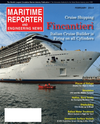
Page 49: of Maritime Reporter Magazine (February 2013)
Cruise & Passenger Vessel
Read this page in Pdf, Flash or Html5 edition of February 2013 Maritime Reporter Magazine
www.marinelink.com 49NEWSPRODUCTSP-Trap Anti-Boarding Device GAC Maritime Security has added the P-trap anti-boarding device to its range of non-lethal vessel protection solutions. P-trap is an engine blocking system that creates a security zone around the ship to prevent other vessels from approaching too close and attempting to board. Creat-ed by Netherlands-based Westmark BV, the patented anti-boarding device creates a non-lethal secure barrier around a ship, adding an additional layer of protection from attack. A set of long, thin lines are carried on side booms extending up to 10 m from the ship?s bow on both sides of the ship just below the water surface. Any vessel entering this security zone will run into these lines, which trap the propeller and disable the engines, dis-abling the approaching vessel. Designed to be deployed before entering high-risk areas, the P-trap provides continuous protection against multiple attacks, day and night, without the need for crew in-volvement and constant vigilance. GAC Maritime Security, Powered by AKE, is a partnership between global shipping, logistics and marine services provider GAC Group and AKE Group. Email: [email protected] Monitoring for Pipe-Laying Vessel MAATS Tech Ltd. is a specialist ship design organization with expertise in the provision of turnkey carousel sys-tems and associated equipment that are installed in special purpose vessels used for laying ß exible pipe, umbilicals and power cables. On such vessels, the cable or pipe is fed through a tensioner be-fore being loaded to and from the car- ousel system as part of the laying pro-cess. Maintaining the correct tension in the pipe or cable is crucial to achieving its successful seabed deployment, as well as for the avoidance of equipment malfunction and associated downtime. Strainstall was able to provide MAATS with a system comprised of bespoke load cells and ampliÞ ers to provide real-time information on pipe/cable tension levels. Readings from the load cells are sent di-rectly to the tensioner controls, enabling the system to increase or decrease the tension as required to ensure that the correct levels are always maintained. As the tensioners are mounted on the deck of the vessel, the use of Strainstall?s ma- rine load cells ? proven in harsh environ-ments? was an important factor in meet-ing customer requirements. www.strainstall.com Rolls-Royce 36MW Gas Turbine for Aircraft Carrier Rolls-Royce completed the installation of the Þ rst MT30 gas turbine into the Royal Navy?s new aircraft carrier HMS Queen Elizabeth, at Babcock?s Rosyth shipyard in Scotland. The MT30, at 36 MW (around 50,000 hp), and is touted as the world?s most powerful marine gas turbine. Two MT30s will be installed in each ship and will provide two thirds of the 109 MW needed to power the 65,000 ton ships. The MT30s are installed as part of a Gas Turbine Alternator (GTA) which also includes an alternator and gas turbine enclosure, weighing a total of 120 tons. The installation involved the lifting of the MT30 gas turbine and as-sociated ancillary equipment - housed in a steel package known as the gas turbine enclosure - onto the ship structure. With the enclosure in place, the large alterna- tor, which is driven by the gas turbine to produce electrical power, was then hoisted into place. ECDIS Workbook from Transas Marine Transas Marine pub- lished an ECDIS Workbook which can be used together with the Transas EC- DIS demo software, both available for free download from the company?s website. According to the STCW 2010 Code, EC- DIS training is mandatory for all Deck ofÞ cers serving on board ships Þ tted with ECDIS equipment. The main goal of the ECDIS Demo Workbook is to pro- vide the vessel?s crew with knowledge, understanding and proÞ ciency in the use of Navi-Sailor 4000 ECDIS and Chart Assistant Utility. www.ecdis Þ t.com/request_workbook Hartzell Air MovementHartzell Air Movement released its new medium pressure, ad-justable pitch propeller for marine duty applications. The new die-cast aluminum propeller has been engineered to enhance the op-erating performance of their Series 44M Ductaxial fan. The Series 44M with the new AM propeller is available in sizes 12 to 48 in. and produces up to 65,000 CFM and up to 4 in. of static pressure. www.hartzell.com HullBUG Autonomous Hull Cleaning System SeaRobotics delivered the Þ rst HullBUG (Hull Bio-inspired Underwater Grooming) System to the Center for Corrosion and Biofouling Control at Florida Institute of Technol- ogy in Melbourne. This will be tested and further developed at the newly commissioned Large Scale Seawater Facility, which is located at Port Canaveral and funded by the U.S. Navy OfÞ ce of Naval Research (ONR). HullBUG is an autonomous underwater vehicle designed to crawl on ship hulls or other underwater structures and ?groom? their surface, keeping them clean of marine growth and the surfaces in a smooth condition.Geoffrey Swain, Florida Tech professor of ocean engineering, heads the R&D project at the university, joined by John Hearin, a post-doc researcher. They and their undergraduate and graduate students have begun putting HullBUG through its paces on an 8 x 30-ft. steel plate, coated with U.S. Navy-qualiÞ ed antifouling coatings, which simulates a ship?s hull. HullBUG, a small autonomous vehicle weighing 66 to 88 lbs., attaches to the hull and performs a gentle cleaning function, or grooming. Numerous embedded computers per- form navigation and sensing tasks to facilitate grooming the ship hull. The capabilities to attach to ferrous, non-ferrous and Þ berglass hulls and to deploy various sensors allow the HullBUG to meet several inspection challenges. Opportunities are being explored in com-mercial shipping, oil and gas, nuclear and conventional power generation markets.www.searobotics.com MR #2 (42-49).indd 49MR #2 (42-49).indd 492/4/2013 12:21:07 PM2/4/2013 12:21:07 PM

 48
48

 50
50
